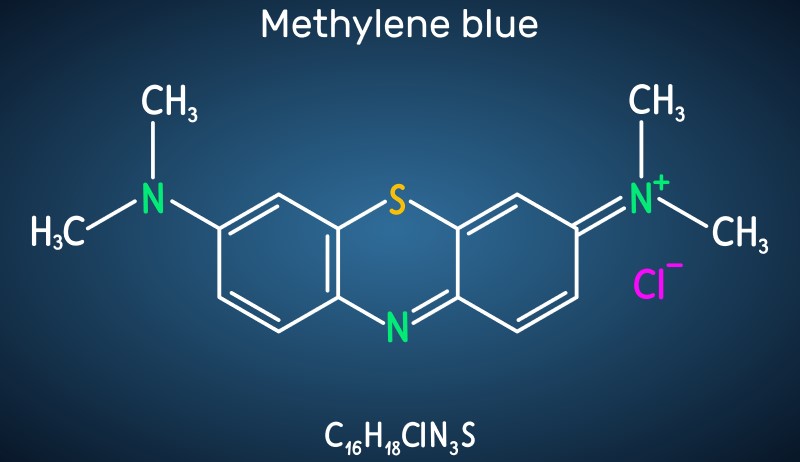
As healthcare professionals, we’re constantly navigating the complexities of medical treatments, weighing the efficacy against potential risks. Enter Methylene Blue: a multifaceted agent steeped in history yet surrounded by modern medical debates.
From its roots as a simple dye to its pivotal role in treating methemoglobinemia, Methylene Blue’s journey through medical science is nothing short of fascinating. However, the critical question lingers. Is Methylene Blue a safe and viable option in today’s clinical practice?
This article aims to unravel the layers of this enigmatic compound by examining its diverse applications, safety profile, and implications for healthcare providers. Whether you’re a seasoned practitioner or a fresh face in the medical field, understanding the nuances of Methylene Blue’s use is crucial. So, let’s get into the science, the controversies, and the potential of this intriguing medical agent.
Methylene Blue Overview
Methylene blue was first synthesized in 1876 (1). Originally used as a textile dye, its journey to a therapeutic agent is a remarkable one.
By the early 20th century, Methylene Blue had found its way into clinical practice, initially used as an antiseptic, then for treating malaria and gonorrhea. Fast forward to today, Methylene Blue’s most recognized and FDA-approved use is in treating methemoglobinemia (2). This is a condition where the blood struggles to deliver oxygen effectively which leads to symptoms like:
- Fatigue
- Shortness of breath
- Skin discoloration
This application of Methylene Blue is crucial, considering that methemoglobinemia, although rare, can have serious implications if left untreated. The compound’s ability to revert methemoglobin back to hemoglobin is a life-saving intervention.
Is methylene blue safe? While its efficacy is clear in certain medical scenarios, understanding its broader safety profile is essential for healthcare practitioners.
Mechanism of Action
Delving into the mechanism of action of Methylene Blue reveals its intricate workings at a cellular level. The compound operates primarily within the mitochondria where it influences energy production.

Electrons in the mitochondrial electron transfer chain are transferred from complex I – complex IV, providing the transmembrane potential to drive production of ATP by complex V. Electron leakage from complex I and complex III acts as the main cellular source of ROS production. MB has been demonstrated as an alternative mitochondrial electron transporter to reroute electrons directly from complex I to complex III, avoiding electrons leakage and subsequent ROS production. This significantly facilitates complex IV activity, increasing mitochondrial respiration. Diagram and block quote from: https://www.ncbi.nlm.nih.gov/pmc/articles/PMC5826781/
This action is pivotal in its role as a treatment for methemoglobinemia. Here, Methylene Blue facilitates the conversion of methemoglobin back to its normal state, hemoglobin, to enable effective oxygen transport throughout the body.
Additionally, Methylene Blue functions as an antioxidant (3). This aspect of its action has sparked interest in exploring its potential beyond treating methemoglobinemia.
By combating oxidative stress, a process that can accelerate aging and contribute to various diseases, Methylene Blue has shown promise in research circles (4). This antioxidant property aligns with the current medical inquiry into the compound’s wider applications.
When considering Methylene Blue dosage, it’s vital to note that its efficacy and safety are dose-dependent. The therapeutic window is narrow, and healthcare providers must exercise caution to avoid adverse effects, especially when administering Methylene Blue intravenously.
Precise dosing, tailored to individual patient needs and medical conditions is key in harnessing the benefits of Methylene Blue while minimizing risks.
Potential Therapeutic Applications
Methylene Blue’s journey in the medical field has opened doors to potential therapeutic applications beyond its primary use. One such intriguing area is its role in anti-aging research (5).
Scientists are exploring how its antioxidant properties might slow down the aging process. These investigations are still in the early stages, but the results could be groundbreaking.
Another promising avenue is the use of Methylene Blue in treating certain types of circulatory shock (6). In these critical conditions, the compound’s ability to enhance cellular oxygen utilization could be a game-changer. Furthermore, the antiviral properties of Methylene Blue have led to its exploration as a potential treatment for viruses, including HIV (7) and herpes (8).
A growing area of interest is Methylene blue injection in skin therapies. Its application in skin creams and other topical treatments is being researched, with the goal of harnessing its properties to improve skin health and appearance.
Safety Profile and Side Effects
Like any medication, Methylene Blue comes with side effects and risks. One common effect noted with Methylene blue administration IV is a temporary blue discoloration of tongue urine and skin. While generally harmless, this can be surprising for patients and practitioners alike.
More serious side effects include nausea, dizziness, and headaches. In rare cases, especially with high doses, Methylene Blue can paradoxically induce methemoglobinemia; the very condition it’s meant to treat. This highlights the need for careful dosing and monitoring.
Drug interactions are a critical aspect of Methylene Blue’s safety profile. It can interact adversely with several commonly used medications, including selective serotonin reuptake inhibitors (SSRIs) and serotonin-norepinephrine reuptake inhibitors (SNRIs).
These interactions can lead to serotonin syndrome, a potentially life-threatening condition. Therefore, a thorough review of a patient’s medication history is essential before administering Methylene Blue.
Pregnant and breastfeeding women should avoid Methylene Blue due to potential risks to the fetus and infant. Additionally, patients with certain genetic conditions like G6PD deficiency should not use Methylene Blue, as it can exacerbate their condition.
Clinical Considerations and Best Practices
In the realm of clinical practice, the safe administration of Methylene Blue is paramount. Healthcare professionals must stay vigilant about dosing, particularly because the therapeutic window of Methylene Blue is narrow. An incorrect dose can lead to adverse effects or diminished efficacy.
An example in treating methemoglobinemia, the recommended dosage is typically 1-2 mg/kg body weight, administered over a 5-minute period.
Another key consideration is the patient’s medical history. Before administering Methylene Blue, it’s essential to review the patient’s current medications to avoid harmful drug interactions. This is especially important with medications like SSRIs, where the risk of serotonin syndrome is significant.
Continuous monitoring of the patient post-administration is also crucial. Observing for any adverse reactions, such as skin discoloration or signs of serotonin syndrome, allows for prompt response if complications arise.
Embrace the Future of Medical Innovations
In a landscape of ever-advancing medical treatments, Methylene Blue stands as a testament to both historical ingenuity and contemporary challenges. At International IV Nutritional Therapy, we believe in empowering healthcare professionals with the knowledge and skills to navigate these complexities.
Our extensive experience in IV therapy and commitment to safe medical practices make us a trusted partner in your professional growth. We invite you to join us in our upcoming seminars, where the fusion of history, science, and modern applications comes alive.

